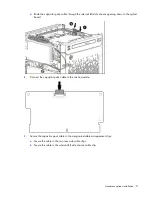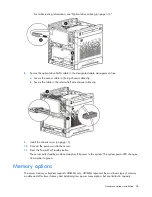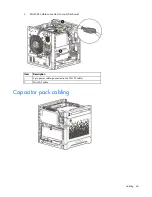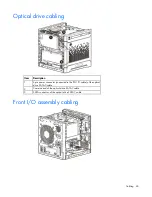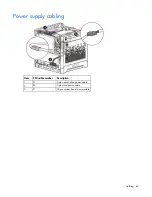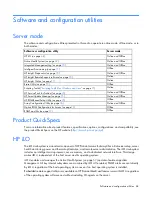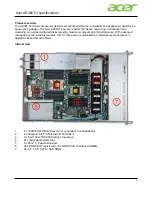
Hardware options installation 56
Item Description
Definition
5
Memory speed
12800 = 1600-MT/s
10600 = 1333-MT/s
8500 = 1066-MT/s
6
DIMM type
R = RDIMM (registered)
E = UDIMM (unbuffered with ECC)
L = LRDIMM (load reduced)
For the latest supported memory information, see the QuickSpecs on the HP website
(
http://www.hp.com/go/qs
). At the website, choose the geographic region, and then locate the product by
name or product category.
Single-rank and dual-rank DIMMs
DIMM configuration requirements are based on these classifications:
•
Single-rank DIMM—One set of memory chips that is accessed while writing to or reading from the
memory.
•
Dual-rank DIMM—Two single-rank DIMMs on the same module, with only one rank accessible at a time.
The server memory control subsystem selects the proper rank within the DIMM when writing to or reading
from the DIMM.
Dual-rank DIMMs provide the greatest capacity with the existing memory technology. For example, if current
DRAM technology supports 2-GB single-rank DIMMs, a dual-rank DIMM would be 4 GB.
Memory subsystem architecture
The memory subsystem in this server is divided into channels. The processor supports two channels, and each
channel supports a DIMM slot.
Channel
Population order
Slot number
1
A
1
2
B
2
DIMM slots are identified by number and by letter. Letters identify the population order. Slot numbers are
reported by ROM messages during boot and are used for error reporting. For the DIMM slot locations, see
"DIMM slot locations (on page
11
)."
ECC memory
The server supports the standard ECC memory correction mode. Standard ECC can correct single-bit memory
errors and detect multibit memory errors. When multibit errors are detected, the error is signaled to the server
and causes the server to halt.
General DIMM slot population guidelines
•
The server supports a maximum of 16 GB memory using two 8 GB single-rank or dual-rank UDIMMs.
•
The server supports up to 1600 MT/s ECC UDIMMs.










